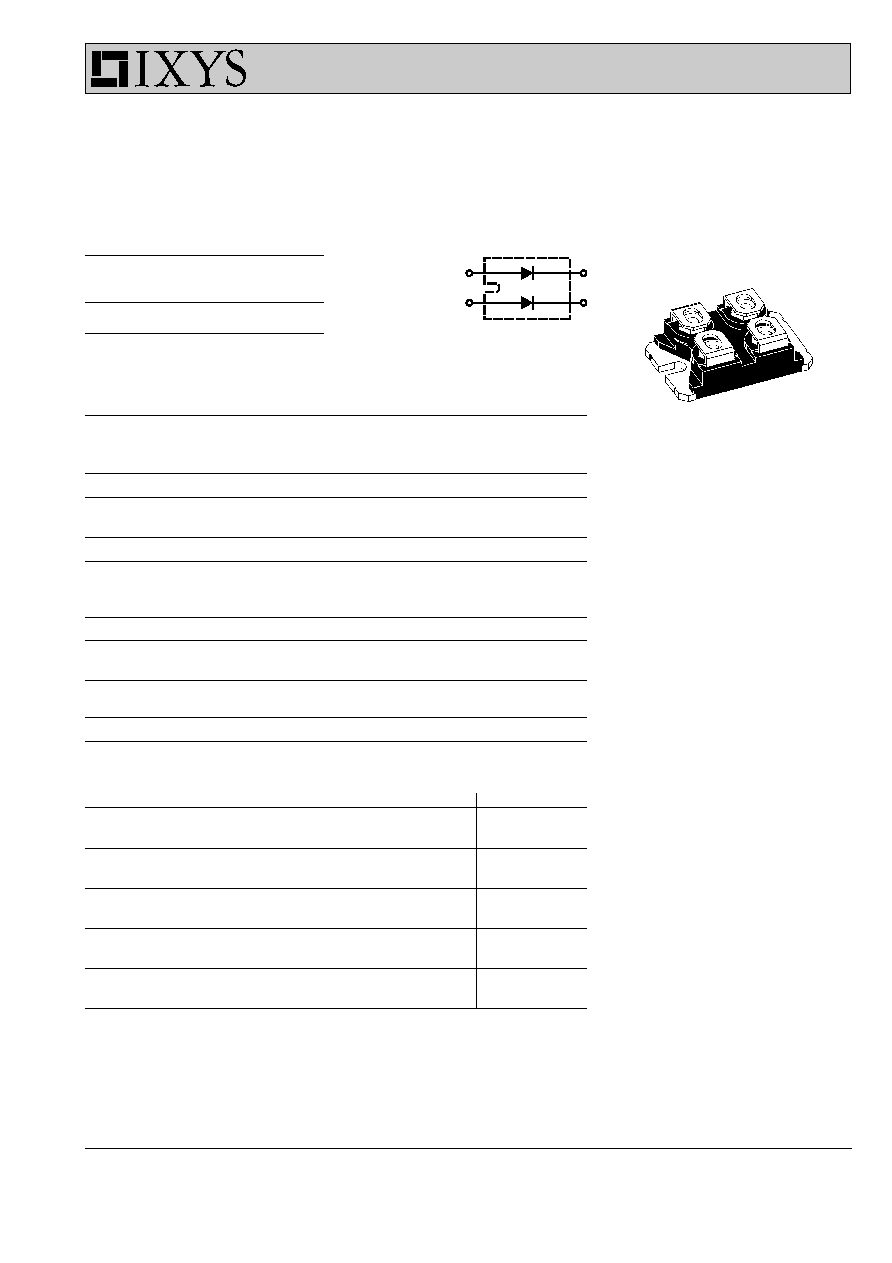
© 2000 IXYS All rights reserved
1 - 2
HiPerFRED
TM
Epitaxial Diode
with soft recovery
Features
q
International standard package
miniBLOC
q
Isolation voltage 2500 V~
q
UL registered E 72873
q
2 independent FRED in 1 package
q
Planar passivated chips
q
Very short recovery time
q
Extremely low switching losses
q
Low I
RM
-values
q
Soft recovery behaviour
Applications
q
Antiparallel diode for high frequency
switching devices
q
Antisaturation diode
q
Snubber diode
q
Free wheeling diode in converters
and motor control circuits
q
Rectifiers in switch mode power
supplies (SMPS)
q
Inductive heating
q
Uninterruptible power supplies (UPS)
q
Ultrasonic cleaners and welders
Advantages
q
Avalanche voltage rated for reliable
operation
q
Soft reverse recovery for low
EMI/RFI
q
Low I
RM
reduces:
- Power dissipation within the diode
- Turn-on loss in the commutating
switch
Dimensions see outlines.pdf
miniBLOC, SOT-227 B
Pulse test:
x
Pulse Width = 5 ms, Duty Cycle < 2.0 %
y
Pulse Width = 300
m
s, Duty Cycle < 2.0 %
Data according to IEC 60747 and per diode unless otherwise specified
IXYS reserves the right to change limits, test conditions and dimensions.
DSEP 2x 91-03A
I
FAV
= 2x 90 A
V
RRM
= 300 V
t
rr
= 30 ns
V
RSM
V
RRM
Type
V
V
300
300
DSEP 2x 91-03A
Symbol
Conditions
Maximum Ratings
I
FRMS
100
A
I
FAVM
T
C
= 65°C; rectangular, d = 0.5
90
A
I
FSM
T
VJ
= 45°C; t
p
= 10 ms (50 Hz), sine
1000
A
E
AS
T
VJ
= 25°C; non-repetitive
2.1
mJ
I
AS
= 4 A; L = 180 µH
I
AR
V
A
= 1.5·V
R
typ.; f = 10 kHz; repetitive
0.4
A
T
VJ
-40...+150
°C
T
VJM
150
°C
T
stg
-40...+150
°C
P
tot
T
C
= 25°C
200
W
V
ISOL
50/60 Hz, RMS
2500
V~
I
ISOL
£
1 mA
M
d
mounting torque (M4)
1.1-1.5/9-13
Nm/lb.in.
terminal connection torque (M4)
1.1-1.5/9-13
Nm/lb.in.
Weight
typical
30
g
Symbol
Conditions
Characteristic Values
typ.
max.
I
R
x
T
VJ
= 25°C
V
R
= V
RRM
1
mA
T
VJ
= 150°C V
R
= V
RRM
4
mA
V
F
y
I
F
= 90 A;
T
VJ
= 125°C
1.30
V
T
VJ
= 25°C
1.72
V
R
thJC
0.60
K/W
R
thCH
0.1
K/W
t
rr
I
F
= 1 A; -di/dt = 400 A/
m
s;
30
ns
V
R
= 30 V; T
VJ
= 25°C
I
RM
V
R
= 100 V; I
F
= 200 A; -di
F
/dt = 100 A/
m
s
5.4
A
T
VJ
= 100°C
Preliminary Data
009

© 2000 IXYS All rights reserved
2 - 2
DSEP 2x 91-03A
200
600
1000
0
400
800
40
50
60
70
80
90
100
0.00001
0.0001
0.001
0.01
0.1
1
0.0001
0.001
0.01
0.1
1
0
40
80
120
160
0.0
0.5
1.0
1.5
K
f
T
VJ
°C
-di
F
/dt
t
s
K/W
0
200
400
600
800
1000
0
5
10
15
0.0
0.3
0.6
0.9
V
FR
di
F
/dt
V
200
600
1000
0
400
800
0
10
20
30
100
1000
0
200
400
600
800
1000
0
1
2
0
40
80
120
160
I
RM
Q
r
I
F
A
V
F
-di
F
/dt
-di
F
/dt
A/
m
s
A
V
nC
A/
m
s
A/
m
s
t
rr
ns
t
fr
A/
m
s
µ
s
DSEP 2x91-03B
Z
thJC
I
F
= 180A
I
F
= 90A
I
F
= 45A
T
VJ
= 100°C
V
R
= 150V
T
VJ
= 100°C
I
F
= 90A
Fig. 3 Peak reverse current I
RM
versus -di
F
/dt
Fig. 2 Reverse recovery charge Q
r
versus -di
F
/dt
Fig. 1 Forward current I
F
versus V
F
T
VJ
= 100°C
V
R
= 150V
T
VJ
= 100°C
V
R
= 150V
I
F
= 180A
I
F
= 90A
I
F
= 45A
Q
r
I
RM
Fig. 4 Dynamic parameters Q
r
, I
RM
versus T
VJ
Fig. 5 Recovery time t
rr
versus -di
F
/dt
Fig. 6 Peak forward voltage V
FR
and t
fr
versus di
F
/dt
I
F
= 180A
I
F
= 90A
I
F
= 45A
t
fr
V
FR
Fig. 7 Transient thermal resistance junction to case
T
VJ
=150°C
T
VJ
=100°C
T
VJ
= 25°C
NOTE: Fig. 2 to Fig. 6 shows typical values
Constants for Z
thJC
calculation:
i
R
thi
(K/W)
t
i
(s)
1
0.212
0.0055
2
0.248
0.0092
3
0.063
0.0007
4
0.077
0.0391
009

